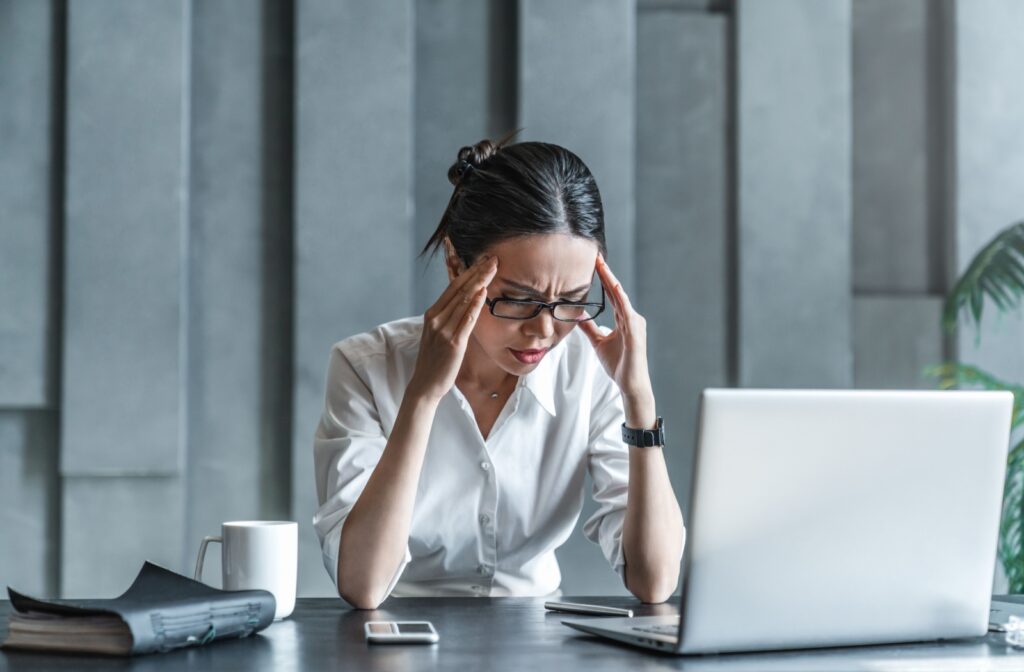In our digital age, staring at screens for hours on end is the norm for both students and working professionals. Whether it’s grinding through spreadsheets, attending endless Zoom meetings, or burning the midnight oil to cram for an exam, many people are constantly exposed to screens emitting blue light.
This exposure has been linked to digital eye strain, which can lead to symptoms like dry eyes, blurred vision, and, notably, headaches. Enter blue light glasses—a trendy accessory marketed as a remedy. But do they really work? You might want to ask, at your next eye exam, whether blue light glasses work as well as people sometimes claim.
While blue light glasses may help some individuals reduce headaches and other symptoms of digital eye strain, they aren’t a guaranteed solution for everyone. Their effectiveness largely depends on individual responses and the underlying causes of the headaches.
Understanding Blue Light and Its Effects
Blue light is a high-energy visible light with short wavelengths that penetrates the eye’s structure more deeply. While blue light is naturally emitted by the sun and plays a crucial role in regulating our sleep-wake cycle, our increased use of digital devices has significantly amplified our exposure. The question is whether prolonged exposure to artificial blue light from screens can disrupt our circadian rhythms and contribute to eye discomfort.
Symptoms of Digital Eye Strain
Digital eye strain, also referred to as computer vision syndrome, encompasses a range of symptoms caused by prolonged screen time. Key symptoms include:
- Dry eyes due to reduced blinking while staring at screens.
- Blurred or double vision, making it difficult to focus on the screen.
- Neck and shoulder pain from poor posture.
- Headaches, which can stem from eye fatigue or tension around the temples and forehead.
Given these symptoms, it’s no surprise that many are turning to solutions like blue light glasses to try to alleviate discomfort.
What Are Blue Light Glasses?
Blue light glasses are specialized eyewear designed to filter or block blue light emitted from digital screens. These glasses have lenses with a coating that reflects blue light or absorbs it, reducing the amount that reaches your eyes. By diminishing the wearer’s exposure, blue light glasses aim to alleviate the symptoms associated with digital eye strain.
Do Blue Light Glasses Really Help with Headaches?
The effectiveness of blue light glasses in preventing headaches is still a subject of debate among experts. Here are some points to consider:
Potential Benefits
- Reduced Eye Strain: By limiting blue light exposure, these glasses may reduce digital eye strain. Less strain can mean fewer tension headaches for some users.
- Improved Sleep Quality: Since blue light can interfere with melatonin production, wearing blue light glasses in the evening can help maintain natural sleep cycles. Better sleep can lead to fewer headaches.
- Comfort During Screen Time: Many users report experiencing less glare and improved comfort when wearing these glasses, which can indirectly reduce headache frequency.
Scientific Evidence
While anecdotal evidence suggests blue light glasses can help reduce headaches, scientific studies offer mixed results:
- Positive Findings: Some studies indicate that blue light glasses can effectively reduce digital eye strain symptoms, including headaches, particularly for those who spend extended periods in front of screens.
- Skepticism: Other experts argue that the primary cause of headaches from screen use is not blue light, but rather the overall strain from prolonged screen use. These experts suggest that other factors, such as poor lighting, screen glare, and ergonomics, play a more significant role.
Other Ways to Prevent Headaches from Screen Use
If you’re experiencing frequent headaches from screen use, consider some of the following strategies:
Follow the 20-20-20 Rule
Every 20 minutes, take a 20-second break to look at something 20 feet away. This simple exercise helps relax your eye muscles and reduce strain.
Adjust Your Workspace
- Lighting: Ensure your workspace is well-lit to minimize glare and reduce the contrast between your screen and the surrounding environment.
- Screen Position: Position your screen at eye level and about an arm’s length away to promote good posture and reduce strain.
Use Screen Filters and Settings
- Brightness and Contrast: Adjust your screen’s brightness and contrast to comfortable levels.
- Night Mode: Use night mode settings on your devices to reduce blue light emission in the evening.
Stay Hydrated
Dehydration can exacerbate headaches, so make sure to drink plenty of water throughout the day.
Should You Consider Blue Light Glasses for Headaches?
For students and working professionals, adopting a holistic approach that includes ergonomic adjustments, regular breaks, and staying hydrated can be an effective way of dealing with headaches. If you’re considering blue light glasses, they might be worth a try as part of a broader strategy to enhance your comfort and productivity during screen time.
Ultimately, listening to your body and consulting with an eye care professional if you experience persistent discomfort or headaches is essential. For more information on blue light glasses and headaches, contact Eclectic Eyewear in Austin, TX today!
Navigating the digital world doesn’t have to be a literal pain, and with the right tools and habits, you can protect your eyes and enjoy your screen time without worry.


